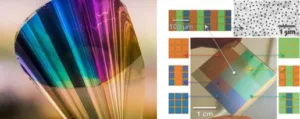A new type of reflective e-paper material and display is under development by a team headed by Andreas Dahlin within the Department of Chemistry and Chemical Engineering at Chalmers University of Technology, (Göteborg, Sweden). It is flexible, ultrathin and reported as able to present the full range of colors that can be produced by an LED-backlit LCD.
The Chalmers researchers explain that, when working on placing conductive polymers on nanostructures, they discovered that the combination could be well suited to creating very thin electronic displays. An article presenting recent work by the team is entitled “Plasmonic Metasurfaces with Conjugated Polymers for Flexible Electronic Paper in Color.” The article was published in the on-line version of the journal Advanced Materials on September 27. A copy of the article is available for purchase here. A great deal of technical information is available in this article on the configuration and principles of operation of the material and device.
The team reports achieving an electrochromic material potentially suitable for use in large area applications. The following properties are reported:
- Good contrast of 30%-50%
- High polarization-independent reflection in air of >90%
- Ultra-low power consumption of <0.5 mW/cm² (the researchers point out that this is one tenth the energy utilized by the E-ink display in a Kindle).
- Ultra-thin at less than one micron thick
- Flexible
- Expected long term stability
The refresh rate of the image is modest at only a few times per second. The resolution is, however, potentially far greater than that available in either a conventional LCD or existing e-paper displays. The team has not yet actually tested the resolution limit but suggest that it might be as high as 104 dpi – this translates to less than one micron and is about an order of magnitude higher than the dpi in an iPhone display.
The status of the research effort is that, at this time, the team has built and tested a few devices that include red, green and blue subpixels. The team believes that the material can be scaled up for commercial applications. There are, however, still some hurdles that need to be overcome. One of these is the cost of the display due to it’s use of gold and silver. Dahlin stated that “The gold surface is 20 nm thick so there is not that much gold in it. But at present there is a lot of gold wasted in manufacturing it. Either we reduce the waste or we find another way to reduce the production cost.” If cost reduction can be sufficiently achieved, then the technology may indeed have commercial potential. – Arthur Berman
Chalmers University of Technology, Andreas B. Dahlin, [email protected]

